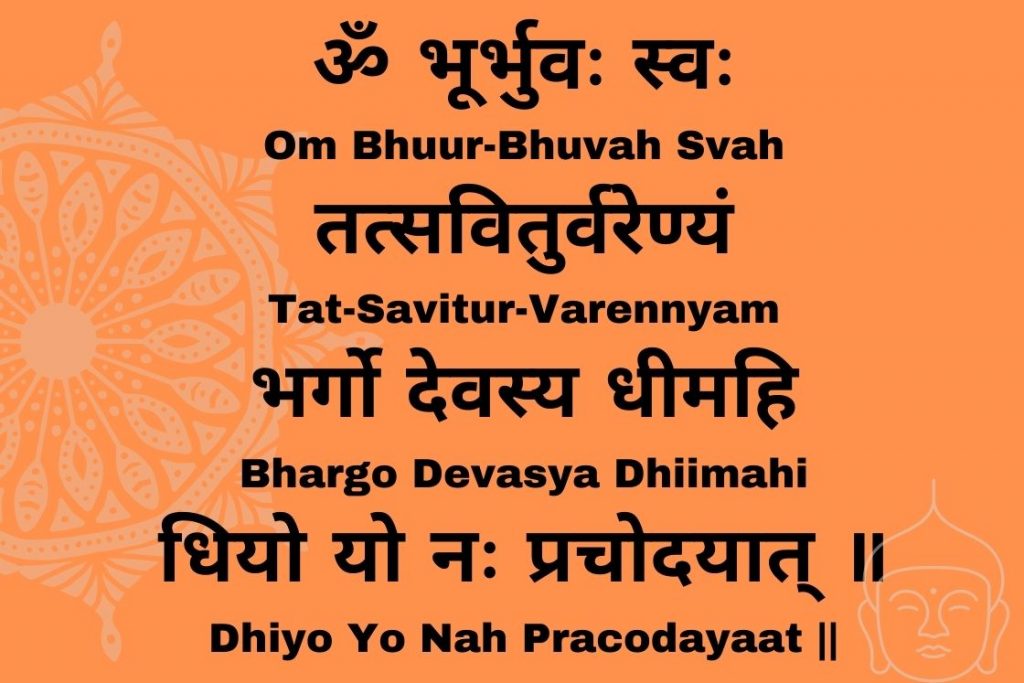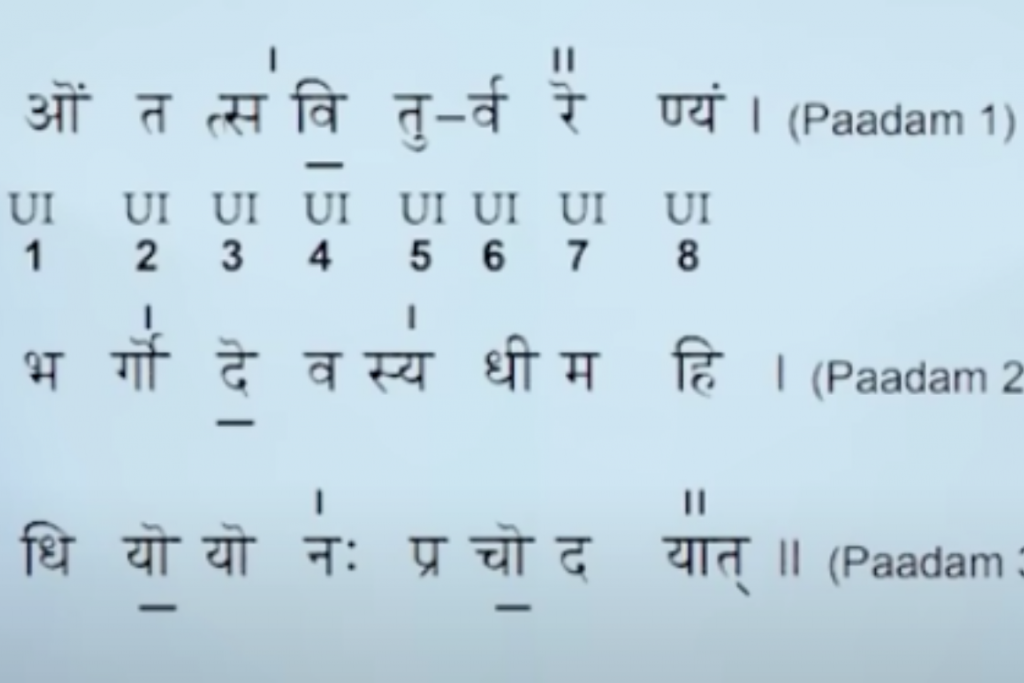
The Gayatri mantra has been revered as the most powerful of all mantras mentioned in Vedas. Also known as Savitri Mantra, it is a commonly recited mantra in rituals, prayers and meditation sessions.
Different mantras are chanted in yoga during meditation and as initial prayers before a session begins. The sound produced through mantra chant removes mental clutter and create a deeper state of awareness.
In this article, we will look into the meaning of Gayatri mantra, benefits of chanting it and its reference in context to Hinduism.
The Mantra
Oṃ bhūr bhuvaḥ svaḥ
tat savitur vareṇyaṃ
bhargo devasya dhīmahi
dhiyo yo naḥ prachodayāt
Origin
The reference of the Gayatri mantra is found in Rigveda, the oldest of the sacred books of Hinduism. It is composed around 3500 years ago.
It is said Sage Vishwamitra received the Gayatri mantra after years of penance from Brahma, the God of creation. On enlightenment, Sage offer this mantra to the entire world for the upliftment of humankind. Some Vedic texts mention Goddess Gayatri is another name of Saraswati or her form and is the consort of Lord Brahma. Therefore, chanting Gayatri mantra is considered an invocation of Saraswati, the Goddess of wisdom.
Gayatri mantra is named after Hindu Goddess “Gayatri” which represents the untiring pursuit of wisdom. In Vedic literature, Gayatri is portrayed as the female form of the light of the sun. She is called “Savitr” – the Vedic Sun Goddess. Sun light itself denotes the wisdom that enlightens the soul.
The word Gayatri is a combination of ‘Gaya’ which means the hymn of wisdom and ‘Tri’ represents the combined strength of the three Hindu Goddesses; Lakshmi (wealth goddess), Saraswati (wisdom goddess) and Mahakali (strength goddess). Sanskrit phrase “Gayantam Trayate Iti Gayatri” explains the significance of chanting this Mantra. It means “On singing (or chanting) which mantra the chanter rescues from all adverse situations that may lead to mortality is called the Gayatri mantra”.
Gayatri mantra is dedicated to increasing the intellect, wisdom, and knowledge of the reciter. It is known as the Maha Mantra which can help in bringing anime, fame, money, prosperity, and peace.
The use of the Gayatri mantra is most prevalent across various daily rituals, meditative practices, and yajnas.
In ancient times and even today, the Gayatri mantra is recited during the upanayana ceremony (a Hindu ritual that marks the acceptance of students by their guru). This is the reason it’s also called Guru Mantra. The mantra is recited by dvija (Brahaman) men, who also recite the mantra as a part of their daily rituals.
Breakdown of The Mantra
Today’s version of Gayatri Mantra is a combination of Yajurveda Mantra “Oṃ bhūr bhuvaḥ svaḥ” and Rigveda verse 3.62.10.
The original Gayatri mantra has three lines only; it goes like this.
“Tat Savitur Varenyam,
Rigveda 3.62.10
Bhargo Devasya Dhimahi,
Dheo Yonah Prachodayat!”
In Vedic mantras, the arrangement of sounds is set to a particular meter. A specific combination of short and long syllables is called “chhandas” in Sanskrit. The “gayatri chhandas” or Gayatri Meter is the most famous among Vedic hymns on which this mantra is named Gayatri Mantra.
The “chhandas” can be thought of as the rhythm that drives the tune of the chant.
The characteristic of “gayatri chhanda” in the Gayatri mantra is such that, each line (Padam) has 8 syllables or root sounds in it. In this way, originally there are 24 syllables in the Gayatri mantra. It goes like this.

tat, sa, vi, tur, va, re, ṇi, yaṃ,
bhar, go, de, va, sya, dhī, ma, hi,
dhi, yo, jo, naḥ, pra, cho, da, yāt.
The specific sound of Gayatri mantra syllables denotes various planes of existence in the cosmos and subtlety within the human body. They represent various parts of the human body and the power associated with them.
Meaning of Gayatri Mantra
The Gayatri Mantra goes as follows:
oṃ bhūr bhuvaḥ svaḥ
tat savitur vareṇyaṃ
bhargo devasya dhīmahi
dhiyo yo naḥ prachodayāt
“Oh (tat), creator (savitur) of the universe (devasya).
We meditate (dhīmahi) upon thy supreme splendor (vareṇyaṃ).
May thy (yo) radiant power illuminate (prachodayāt) our intellects (dhiyo), destroy our (naḥ) ignorance and guide us in the direction of enlightenment (bhargo) by purifying our inner hearts.”
Let us look at the words in a deeper sense.
Om is the para brahman. It is the sound that was created when the universe was being made. Thus it contains the energy of the cosmos and helps the mind align with the supreme power.
bhūr (physical plane) bhuvaḥ (space) svaḥ (heaven) are the vyahrtis where we acknowledge that God is present everywhere and by invoking that Supreme Power, we are asking them to illuminate our beings with creativity, intellect and intuition.
Combined with Om, it becomes a maha vyahrtis or the Great Utterance.
It will be interesting to know that the verse oṃ bhūr bhuvaḥ svaḥ is not a part of the original Gayatri mantra. It has been described in the Taittiriya Aranyaka to prefix this verse before reciting the mantra.
tat literally means that. Here “that” refers to God, the supreme power, brahman. The reciter is referring to God in the third person.
savitur means the Sun. The word is derived from the word Savita meaning the Vedic sun deity Savitr. Sun is referred to here in a spiritual sense. It is the sun that gives us energy and the ability of God through which most life forms of the earth are born. It can also mean divine light of knowledge.
vareṇyaṃ means adoration or one who is fit to be worshiped. By reciting this mantra, the reciter accepts that God is the Highest reality and all our efforts are dedicated to him.
bhargo is the radiance, divine or glorious light of God. God is pure and it is him/her who has the absolute ability to purify each soul by destroying every sin and affliction. Thus by building oneness with God, a human being can cleanse themselves and become pure.
devasya is derived from the word Deva which simply means God.
dhīmahi means to meditate. While reciting the mantra, the mind is free from any distractions to realize the absolute purity of God. The mind should be free from thoughts to become one with the Supreme Power.
dhiyo is the Sanskrit word for intellect. With God in the mind, one should now strive to benefit from the divine presence and influence the mind and intellect
yo means who or that. This refers to God whom we are praying and praising.
naḥ means ours. Here we are not praying for personal benefit but for the upliftment of the entire humankind.
prachodayāt is the last word of the mantra which invokes enlightenment from the divine light. May God direct us in the right way by removing darkness from our paths. May God take us in his sanctuary so that we may experience true peace, happiness, and bliss.
Importance of chanting Gayatri Mantra
The Gayatri Mantra has the power to enhance self-control, creativity, intellect, focus, and concentration through which you can achieve happiness and success in life.
It makes your mind more alert and helps you connect to the higher consciousness, which has also been proven scientifically.
In 2016 a study was conducted on the effects of Gayatri mantra meditation on meditation naive subjects. The subjects were asked to listen to Gayatri Mantra for 15 minutes. The consequent EEG found a substantial increase in the gamma (high level of conscious awareness) and beta (alert mind) waves in the brain.
The fMRI, which measures the changes in blood flow during brain activity, revealed that various brain areas were activated. The right-insula, which is responsible for bodily awareness and the emotional experience was one amongst them.
This breakthrough study is proof that Gayatri mantra chanting is beneficial for mental growth, peace, clarity, and eliminating negativity.
It is also due to this reason that a child is first taught the Gayatri Mantra.
Gaytri Mantra also helps in opening up the energy channels of the subtle body and ensures powerful energy flow through all the chakras. It also helps in balancing the 3 doshas.
It is especially beneficial for students as per Pandit Shriram Sharma Acharya, who has authored The Super Science of Gayatri and is an authority with relation to Gayatri Mantra. As per him, the Gayatri Mantra contains 24 syllables that directly correspond to the 24 qualities of a student.
The 24 syllables and qualities are:
Tat-success; Sa-bravery; Vi-maintenance; Tur-wellbeing; Va-yog; Re– love; Ni-money; Yam– brilliance; Bhar-defence; Go-intellect; De– self control; Va-devotion, Sya-retention; Dhee-Prana (life-breath); Ma-restraint; Hi-penance; Dhi– far-sightedness; Yo-awakening; Yo-power to produce; Naha– sweetness; Pra-ideal; Cho-courage; Da-Wisdom; Yat– service
When you chant Gayatri mantra in a silent and soft voice with a calm mind, your unvoiced wishes will also be fulfilled and also remove fear from within.
Regular meditation with the Gayatri mantra will help you transcend to an elevated plane and achieve enlightenment.
Can women chant Gayatri Mantra?
When the topic of chanting Gayatri mantra comes forth, you will often find this question cropping up – isn’t it forbidden for women to chant Gayatri Mantra?
The answer to this question is not definite. It is said that initially women were allowed to recite Gayatri mantra and also partake or hold holy rituals. But why they were barred also has many theories. In the modern age though, everybody has been given the go of reciting Gayatri Mantra, including women.
Many religious scholars may come forward with the explanation that chanting Gayatri mantra will enhance male qualities in a female such as tone of voice or facial hair, cause issues with menstruation and reproductivity, etc.
If we look into it keeping in mind the chakras, Gayatri Mantra directly impacts the Ajna Chakra. When the mantra is chanted regularly, all energies may flow towards the third eye chakra. This will leave the bottom three chakras – Muladhara, Svadhisthana, and Manipura deprived of their powers.
These three chakras are essential when it comes to a women’s reproductive organs. Thus, the chanting of Gayatri mantra may interfere with their energies and cause an imbalance.
It may also affect the flow of the Apana Vayu, which is a downward flowing vayu, and disrupt the menstrual cycle.
Linking the above aspects with science, when the excess energy will flow towards the pituitary gland (third eye chakra), the secretion of the testosterone-producing hormone will increase. This imbalance of testosterone (male hormone) and estrogen (female hormone) can cause dysfunctional ovaries, increase facial hair, irregular menstrual cycles or PCOD, deepened voice, etc.
However, this is not to say that women absolutely cannot recite the Gayatri Mantra. The verse oṃ bhūr bhuvaḥ svaḥ is said to be added for this reason. In this context, bhūr bhuvaḥ svaḥ helps activate the Muladhara, Svadhisthana, and Manipura respectively.
Benefits of chanting Gayatri Mantra
Since Gayatri Mantra is said to be the most powerful mantra, it comes with a plethora of physical, mental, and spiritual benefits. It not only connects you to the spiritual plane but calms the mind and provides peace and clarity to look into things in a new light.
Let us look at some more benefits of Gayatri Mantra:
- Your blood pressure is kept in check due to synchronized breathing by syncing the heartbeat.
- You use your throat, mouth, lips, and tongue to chant the mantra. This stimulates various nerves due to the vibrations and keeps them functioning healthily.
- You need to chant the mantra with a specific focus on your breath. The short holds of breath help strengthen your lungs and reduce many lung or breathing-related problems
- It will improve your immunity by keeping diseases at bay.
- It improves concentration and focus through which you will be able to achieve your goals.
- Chanting the mantra helps in removing toxins as the vibrations activate the cells which improve the detoxification process.
- The throat, third eye, and crown chakra are stimulated with chanting of the gayatri mantra which improves concentration.
- The positivity gained from the chanting of the mantra helps in reducing stress, anxiety and symptoms of depression.
- With a positive mind, you will also stay away from negative energy and thoughts.
- The above in turn helps in strengthening the mind and improves mental health.
Gayatri Mantra chanting rules
You can chant the Gayatri Mantra at any time of the day, but it will be extremely beneficial if you chant it during the Brahma Muhurta. Early morning or sunrise, noon or sunset (the transition period) are some of the best times to recite the mantra.
If possible, face toward the east in the morning and to the west (as per the rising and setting of the sun) when chanting the mantra.
Chant the Gayatri Mantra a minimum of 3 times. 108 times is considered an auspicious number hence you can either divide this number by 3 (36 times each for sunrise, noon, and sunset) or chant the entire mantra 108 times in one sitting.
Have a clear and pure mind and heart before starting to chant the Gayatri Mantra. A disturbed, distracted, or cluttered mind may make you lose focus and pronounce the words wrong.
While chanting the mantra, close your eyes and sit in a relaxed meditative pose. You can chant it in a slow voice or silently.
Do not rush while chanting, make sure you are chanting each word clearly with appropriate pronunciation and breaks.
Avoid sitting on bare ground as it may cause a loss of energy. Sit on a blanket, cloth mat, or yoga mat.
Women going through pregnancy or menstruation should avoid chanting the Gayatri mantra due to its powerful energy.
You can also chant shanti, shanti, shanti at the end of the mantra invoke peace into the body, mind, and soul.
It is preferable that you perform pranayama before starting the chant. Alternate Nostril Breathing (Nadi Shodhana) is one that can be performed to prepare yourself.
Conclusion
The Gayatri Mantra has been bestowed upon humanity as a way of staying close to divinity. It is an expression of gratitude to the supreme power for giving us life and asking for their blessing to lead us on the right path. You will be able to tap into the higher consciousness and pave a path to enlightenment or samadhi.
If you recite the mantra with utmost dedication and follow the necessary steps listed above, you will surely see the benefits in no time.





Thank you for explaining it so clearly. You’ve almost cleared all my doubts. I have one question though, and it would be great if you could answer it. Is it compulsory to take a bath before chanting? I ask because I have a morning workout routine. Thank you .
Thanks for your comment! I’m glad the article helped clarify things for you. To answer your question: while it’s not strictly compulsory to take a bath before chanting the Gayatri Mantra, it is traditionally recommended as a way to purify yourself and your surroundings. If your morning workout routine makes it challenging to bathe, you can still chant after performing a cleansing ritual, like washing your hands and face. The key is to approach the chanting with a sense of respect and focus.